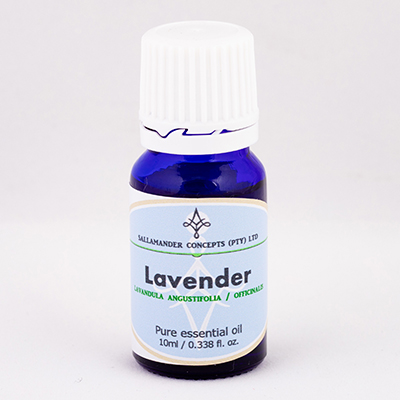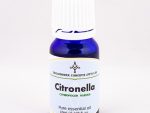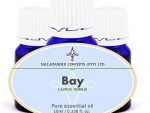Information on Lavender essential oil
Lavender essential oil is extracted from Lavandula angustifolia (also known as Lavandula officinalis, L. spica and L. vera), of the Lamiaceae (Labiatae) family. It is also known as garden, common or English lavender.
It is with good reason that Lavender Essential Oil is one of the most popular essential oils, as it has wonderful qualities and also smells great.
It is a calming, relaxing oil, which combats stress and crisis, while the antiseptic properties helps with cold, flu and other ailments.
It is excellent for asthma and migraines. Apart from that, it supports female health and has a healing effect on the skin, while preventing scarring and balancing the skin.
Oil Properties
Lavender Essential Oil has a light fresh aroma, is clear in color and watery in viscosity.
Origin
It is an evergreen woody shrub about 1 meter high (3 feet), with gray-green narrow linear leaves and the most beautiful purple-blue flowers, perched on a long stem and a few varieties of it grow wild in the Mediterranean region, but the main producer is France.
The name is derived from the Latin word ‘lavera’ which means ‘to wash’ and the Romans used it frequently in their bath routine, and it is said to have been introduced by them into England, where it soon was a firm favorite.
It was a favorite for strewing on the floor, since it released an aroma when walked upon and it is often used these days in toilet water, as an insecticide or in sachets to be placed between linen.
It is also used to clean wounds and to treat burns.
Extraction
Lavender Essential Oil is extracted from the flowering tops by steam distillation and yields 1.4 % – 1.6 %.
Chemical composition
Some of the main chemical components of lavender oil are Linalyl acetate, Linalool, (Z)-β-Ocimene, Lavandulyn acetate, Terpinen-4-ol
Precautions
Although Lavender Essential Oil is considered one of the safest essential oils, you should discontinue use is you have any allergic reactions.
As with most essential oils, this essential oil should be kept in a dark and cool place and should be stored in an airtight glass bottle (Preferably in the fridge at a temperature of around 4° Celsius / 39° Fahrenheit)
Please read our page with heading: Safety with Essential Oils before using this oil.
We recommend the following book as an excellent resource regarding safety:
Essential Oil Safety: A Guide for Health Care Professionals by Robert Tisserand & Rodney Young (#ad)
Therapeutic properties
The therapeutic properties of lavender oil are antiseptic, analgesic, anti-convulsant, anti-depressant, anti-rheumatic, anti-spasmodic, anti-inflammatory, antiviral, bactericide, carminative, cholagogue, cicatrisant, cordial, cytophylactic, decongestant, deodorant, diuretic, emmenagogue, hypotensive, nervine, rubefacient, sedative, sudorific and vulnerary.
Uses
Lavender Essential Oil has a soothing and calming effect on the nerves, relieving tension, depression, panic, hysteria and nervous exhaustion in general and is effective for headaches, migraines and insomnia.
It is also very beneficial for problems such as bronchitis, asthma, colds, laryngitis, halitosis, throat infections and whooping cough and helps the digestive system deal with colic, nausea, vomiting and flatulence.
Lavender oil relieves pain when used for rheumatism, arthritis, lumbago and muscular aches and pains, especially those associated with sport.
On the skin, lavender oil tones and revitalizes and it is useful for all types of skin problems such as abscesses, acne, oily skin, boils, burns, sunburn, wounds, psoriasis, lice, insect bites, stings and also acts as an insect repellent.
Lavender oil is one of the few essentials oils that can be used neat on the skin, and this is especially useful when treating a minor burn wound.
Lavender is a firm favourite when it comes to relaxation. It is for this reason that it is a mojor ingredient in or Relaxation Massage Blend.
Burners and vaporizers
In vapor therapy, lavender oil can be useful for allergies, anorexia, dizziness, sleeplessness (also in children), hay fever, headaches, depression, trauma, anxiety, hysteria, fear, nightmares, irritability, nervous tension and as an insect repellent.
Apart from this, it can assist to lift depression, help in crisis situations, soothe irritability and relieve stress and thereby help with tense muscles and muscle spasms.
Blended Massage Oil or in the Bath
Lavender Essential Oil can be used as a massage oil or diluted in the bath, for abdominal pains, allergies, anorexia, arthritis, bowel disorders, fatigue, hay fever, headaches, insomnia, moodiness, trauma, anxiety, depression, hysteria, nightmares, fear, irritability, nervous tension, stress and just for the plain pleasure of relaxing in such a fragrant surrounding.
Lavender is a firm favourite when it comes to relaxation. It is for this reason that it is a mojor ingredient in or Relaxation Massage Blend.
As a wash or on a cotton bud
Lavender Essential Oil can be used as a wash or on a cotton bud for acne, insect bites, carbuncles, bruises, chilblains, dandruff and lice.
Cold Compress
On a cold compress, lavender oil can be used for: arthritis, eczema and sores.
Blended in a Cream
When it is used in a cream or lotion, it is most helpful with relieving burns. Its cicatrisant properties help the skin heal faster and the cytophylactic properties will help it do so with less scarring.
The soothing and anti-inflammatory action of lavender oil will also have a balancing action on the skin and can be used for dermatitis, eczema, psoriasis, boils, carbuncles and acne.
When employing the anti-inflammatory action of this oil, use in concentrations of less than 1%.
Furthermore it will help ease the pain of sunburn and sunstroke and will also counter the itching effect of insect bites.
Suggested Dilution Rates
On the skin
Adult:
Face: 0.5% to 1.5%
Body: 1.5% to 3%
Bath: 1.5% to 4%
3 to 24 months:
Face: 0.25% to 0.5%
Body: 0.25% to 0.5%
Bath: Maximum of 0.5%
2 to 6 years:
Face: 0.5% to 1.5%
Body: 0.5% to 2%
Bath: 0.5% to 2%
6 to 15 years
Face: 0.5% to 1.5%
Body: 0.5% to 3%
Bath: 0.5% to 3%
Pregnancy
Face: 0.5% to 1.5%
Body: 0.5% to 2%
Bath: 0.5% to 2%
- When in doubt consult your doctor / medical professional before use.
- Most professionals and/or Aromatherapists will always err on the side of safety when giving advice regarding the use of essential oils and oleo resins during pregnancy.
- Quite a number of Aromatherapists advise that you should avoid all essential oils completely while pregnant, specifically during the first trimester. This is a very safe approach but may not be necessary at all.
Diffusers and Vaporisers
4 to 8 drops
General:
- When using for the first time – Always use the lowest dilution rate and build up slowly to the maximum. Stop using all essential oils on the skin if irritation or allergy occurs.
- Any advice or instruction received from a medical professional ALWAYS supersedes recommendations or advice found on this website. When in doubt consult your doctor / medical professional.
Summary
Lavender Essential Oil is one of the most versatile oils and is handy to have around the house, as it can be used for such a variety of problems.
It not only helps with nervous conditions, it is useful for the digestive system, the respiratory tract and skin problems, it also helps with muscle aches and pains and arthritis and rheumatism.
Blends
Although essential oils blend well with one another, lavender oil blends particularly well with Cedarwood, Clary Sage, Geranium, Pine, Nutmeg and all the citrus oils.





